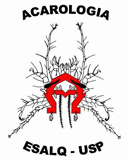The morphological similarity between species of Ascidae Voigts & Oudemans, Blattisociidae Garman and Melicharidae Hirschmann is considerable and for this reason until recently they were all classified as a single family, Ascidae (Lindquist & Evans, 1965). Recent studies (Lindquist et al., 2009) have led to their separation, two of those families (Ascidae and Melicharidae) being placed in Ascoidea, and one (Blattisociidae) in Phytoseioidea. A complete characterization of Ascidae sensu stricto was given by Moraes et al. (2016). Mites of this family can be recognized by the following characteristics:
Ascid species have been described from a wide range of countries and habitats. This data base provides information about the world distribution and habitats occupied by species of this family, which should be of interest to research works dealing with the taxonomy, biology and ecology of these groups, and even to applied biological control activities. Preparation of the base was done by consulting the world literature, starting with the publications cited by Moraes et al. (2016). The taxonomic concept used in this work is based on Moraes et al. (2016), in which detailed information about the nomenclature reported for each genus and species can be found. This data base is updated periodically, as new information becomes available in the literature. A major effort was done to include precise information about all known ascid species, but mistakes and omissions may have happened. We would be grateful to users for letting us know of those mistakes or omissions, so that the information can be corrected or complemented. How to cite
|
|
||
 |
|||
NOTES For some of the species, observations are presented explaining particular situations, such as species of questionable identification (tentative identifications, affinis, “near”, “cf” and “?”), species listed differently from the way that currently (cited as) and species whose information was complemented by queries to the authors (***). |
|||

